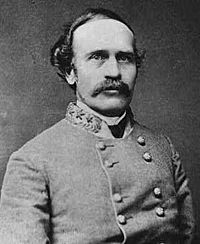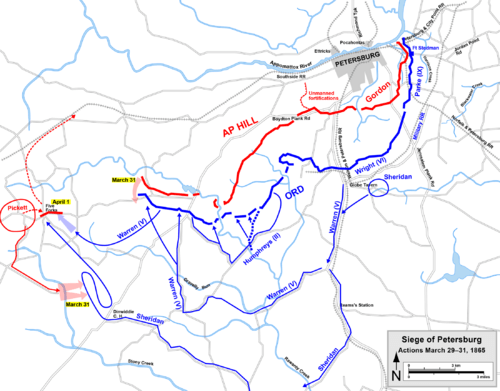Battle of White Oak Road facts for kids
Quick facts for kids Battle of White Oak Road |
|||||||
|---|---|---|---|---|---|---|---|
| Part of the American Civil War | |||||||
|
|||||||
| Belligerents | |||||||
| Commanders and leaders | |||||||
| Gouverneur K. Warren | Robert E. Lee | ||||||
| Units involved | |||||||
| V Corps | Anderson's Corps (Fourth Corps) | ||||||
| Strength | |||||||
| 22,000 | 8,000 | ||||||
| Casualties and losses | |||||||
| 1,870 | 800 | ||||||
The Battle of White Oak Road was fought on March 31, 1865. It was part of the American Civil War, happening near the end of the Richmond-Petersburg Campaign. This battle, along with the Battle of Dinwiddie Court House, was the last time Robert E. Lee's Confederate army tried to stop Ulysses S. Grant's Union forces.
Grant's army was trying to cut off the last supply lines for the Confederates. These lines brought food and supplies to the cities of Petersburg, Virginia and Richmond, Virginia. By cutting these lines, Grant hoped to force Lee's army out of their defenses or into a big battle. The Union won this battle, which helped set the stage for the end of the war.
Contents
Background to the Battle
The War Around Petersburg
The Long Siege of Petersburg
The Siege of Petersburg lasted for 292 days. It was a long period of fighting where Union forces tried to capture Petersburg, Virginia. General Grant used a strategy called "trench warfare." This meant digging long ditches and fighting from them. The goal was to wear down the smaller Confederate army. The Union also tried to cut off all supplies to Petersburg and Richmond.
By early 1865, the Confederate lines were stretched very thin. General Lee knew his army might have to leave Petersburg and Richmond. He hoped to get supplies elsewhere and join another Confederate army. This other army was fighting William Tecumseh Sherman in North Carolina. Lee hoped to defeat Sherman, then return to fight Grant.
Attack at Fort Stedman
In March 1865, General Lee knew his army was in trouble. He approved a plan to attack Fort Stedman, a Union fort. The goal was to break the Union lines or force them to shorten their defenses. This would allow Lee to move some of his troops to help fight Sherman.
On March 25, 1865, Confederates launched a surprise attack on Fort Stedman. They captured the fort and some nearby positions. However, Union troops quickly fought back. They recaptured the fort and forced the Confederates to retreat. The Confederates lost about 4,000 soldiers, which they could not afford.
After this defeat, Lee knew Grant would soon attack his remaining supply lines. These were the Southside Railroad and the Boydton Plank Road. Cutting these would trap the Confederate armies in Petersburg and Richmond.
Union Moves on March 29
Grant's Plan for Attack
Before the Fort Stedman attack, Grant had already planned a big offensive for March 29, 1865. His goals were clear. He wanted to force the Confederates into a major battle and defeat them. He also wanted to cut their last supply routes. These routes connected the Confederacy to Petersburg and Richmond. The Fort Stedman battle did not change Grant's plans.
Grant moved many Union troops to the western side of the Petersburg lines. This included the II Corps and the V Corps. He also sent Philip Sheridan's cavalry west. Their main targets were the Southside Railroad and the Boydton Plank Road. Cutting these would stretch Lee's army to its breaking point.
Lee's Response
Lee was already worried about his army's ability to defend Petersburg. He knew Grant would likely make a move. So, Lee had already prepared to send more troops to the western end of his line. He also planned to send a mobile force to protect a key road junction called Five Forks. These movements began on the morning of March 29.
Union Infantry Advances
On March 29, the Union V Corps, led by Gouverneur K. Warren, moved west. Sheridan's cavalry took a longer route towards Dinwiddie Court House. Warren's troops moved along Quaker Road. They aimed for where it met the Boydton Plank Road and the Confederate White Oak Road Line.
Battle of Lewis's Farm
Along Quaker Road, Warren's troops met Confederate soldiers. A tough fight followed. The Union troops, though, pushed the Confederates back to their White Oak Road Line. Both sides had similar numbers of casualties.
After this battle, Union forces took control of important road junctions. They were now very close to the Confederate lines. They were also in a strong position to attack the Confederate right side. They could also move against Five Forks, a crucial road junction. This junction was key to controlling the Southside Railroad. Grant saw this success and decided to make his offensive even bigger.
After Lewis's Farm: More Movements
Confederate Troop Shifts
After the Battle of Lewis's Farm, Lee moved more troops to strengthen his right side. Heavy rain made troop movements difficult for both sides. Lee also sent George Pickett and Fitzhugh Lee with cavalry to Five Forks. This was about 4 miles from the end of the main Confederate line. Lee was worried about the gap between his main line and Pickett's force.
Union Army Faces Challenges
The heavy rain made it hard for the Union army to move supplies. Many soldiers had to help wagons and horses get through the deep mud. Rivers were swollen, and bridges were washed away.
Despite the bad weather, Union skirmishers kept the Confederates mostly in their lines. Warren pushed his V Corps forward to secure the Boydton Plank Road. They dug trenches to hold their new positions. Humphrey's II Corps also moved closer to the Confederate lines and dug in.
During the night of March 30, Grant decided not to launch a full attack. Instead, he wanted his troops to be ready if the Confederates weakened their lines. He also wanted to shift forces west to help Warren.
Ayres's Division Moves Forward
Romeyn B. Ayres's division of the V Corps moved forward for a look. They went towards White Oak Road. Their lead brigade crossed a swollen stream called Gravelly Run. Ayres did not realize how close they were to strong Confederate defenses. He also didn't see that the Confederate line extended further than he thought. This put his troops in a risky, exposed position.
Opposing Forces
Union Army
Confederate Army
The Battle Begins
Lee Orders an Attack
On the morning of March 31, General Lee saw that the Union line was exposed. He noticed a big gap between the Union infantry and Sheridan's cavalry. Lee ordered Bushrod Johnson to attack this exposed Union position. Johnson's division, with help from other brigades, prepared to strike.
Johnson's Surprise Attack

Before the Confederates could attack, the Union V Corps sent a brigade forward. They wanted to secure their position and push back Confederate pickets. But the Confederates were ready. They were hidden in the woods north of White Oak Road.
As Ayres's division advanced, the Confederates opened fire from the trees. Three Confederate brigades attacked Ayres's division and another Union division. Even though they were outnumbered, the Confederates pushed the Union troops back. They drove them across Gravelly Run.
General Warren himself tried to rally his retreating soldiers. He grabbed a regimental flag and tried to stop the panic. But it was too late for Ayres's division. Warren managed to get the scattered troops to reform behind another Union division. The Confederates stopped their advance about 400 yards from Gravelly Run.
Humphrey's Support Actions
Meanwhile, Andrew A. Humphreys's II Corps had moved into position. When Warren asked for help, Humphreys sent two brigades forward. These brigades surprised the Confederates and pushed them back. They even captured about 100 prisoners.
Humphreys also ordered smaller attacks along the line. These were meant to distract the Confederates. Some Union troops captured parts of the Confederate picket line. Others tried to silence Confederate cannons.
A Missed Chance for the Union
The Confederates pulled back to some trenches that Ayres's men had built the night before. A Union general saw that some Confederate trenches were empty. But a Union attack went to the wrong place. This allowed the Confederates to quickly reoccupy the empty trenches. The Union missed a chance to gain more ground.
Union Counterattack

By 1:00 p.m., the Union line was stable. General Warren asked Joshua Chamberlain to lead a counterattack. Chamberlain had been wounded just two days earlier, but he agreed. At 2:30 p.m., Chamberlain's men crossed the cold Gravelly Run. The rest of Warren's troops followed.
The Confederates fired heavily as Chamberlain's men came out of the woods. Warren told Chamberlain to hold his position. But Chamberlain suggested they attack instead of staying under fire. His brigade, along with another, charged the Confederates. They drove them back to the White Oak Road Line. The Confederates had to retreat to avoid being surrounded.
Warren's men pursued the Confederates across White Oak Road. They gained control of a key part of the road. This cut off direct communication between the Confederate forces.
Battle Casualties
The Union army had about 1,870 casualties (killed, wounded, or captured). The Confederate army had about 800 casualties. These losses were very hard for the Confederates to replace.
Aftermath of the Battle
After the battle, the Confederates had lost control of White Oak Road. They were stuck in their defenses. They also lost their direct communication with Pickett's force. This was a big blow to their army's strength and morale.
While the Union won at White Oak Road, Sheridan's cavalry was in trouble at the Battle of Dinwiddie Court House. The Confederates had pushed them back. Warren sent a brigade to help Sheridan. These troops engaged the Confederates with sniper fire as darkness fell.
Pickett soon realized his position was dangerous. He learned that Union infantry was coming to help Sheridan. This meant his force could be attacked from the side. So, Pickett decided to retreat to Five Forks later that night. This retreat gave him a chance to defend Five Forks and the Southside Railroad.
Many orders and messages were sent between the Union generals that night. Warren's troops faced delays due to swollen rivers and mud. But by dawn, Union divisions arrived to support Sheridan. The Confederates had already retreated.
Warren's gains at White Oak Road on March 31 were very important. His troops helped push Pickett's men back to Five Forks. This set the stage for a major Union victory at the Battle of Five Forks the next day. It also led to the Union breakthrough at the Third Battle of Petersburg on April 2, 1865. These events ultimately led to the surrender of Lee's army.
Battlefield Preservation
Today, parts of the White Oak Road battlefield are preserved. The American Battlefield Trust has helped save over 951 acres of the land. There is a walking trail where you can see old Confederate earthworks and cannon positions. Signs explain the battle that happened there in 1865.


